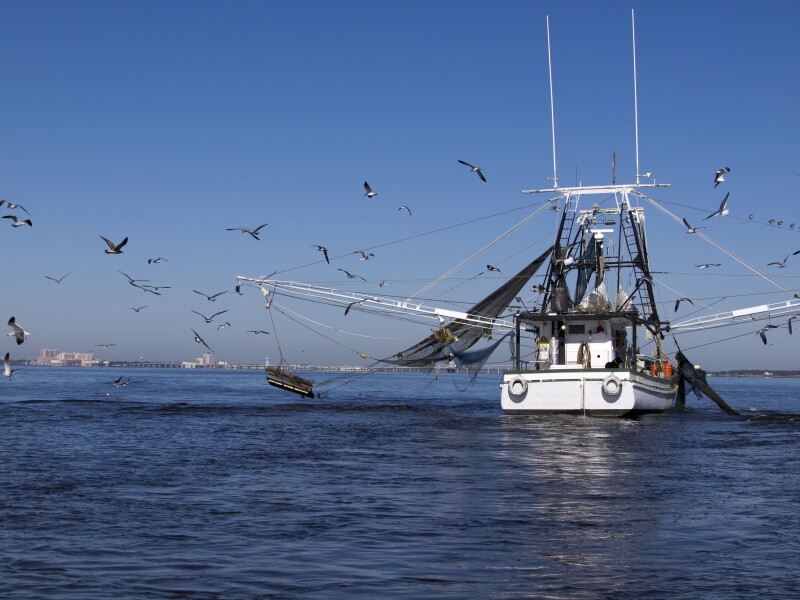U.S.-harvested shrimp has long been an economic backbone and cultural icon for commercial fishing communities, particularly in the Gulf and Southeastern coasts. Known for being nutritious and downright delicious, it’s a sustainable choice that’s not just good on the plate but also responsibly harvested. With the United States setting the global standard for shrimp trawl bycatch reduction, our shrimp fishery is designed to safeguard both marine ecosystems and the fishing industry’s future. But despite this commitment to sustainability, our shrimp industry is struggling to keep afloat. Let’s break down the facts about wild-caught U.S. shrimp and why this fishery is worth supporting.
What Makes Wild-Caught U.S. Shrimp Sustainable?
Thanks to solid science and a dynamic management approach, U.S. fisheries are among the largest and most sustainable in the world, and our shrimp fishery is no exception. NOAA Fisheries carefully manages shrimp harvested here to protect the long-term health of the shrimp populations and their ecosystems. White, pink, and brown shrimp are the backbone of the industry in the Southeast, providing jobs and sustaining generations of fishing families.
Shrimp are fast-growing crustaceans, often hitting 7 to 8 inches within just two years, making them resilient to overfishing. Monitoring programs like fishery-independent surveys and stock assessments help NOAA Fisheries determine the shrimp populations' health and manage their harvest. Temporary closures are sometimes enforced to allow shrimp to migrate offshore and reach larger, more valuable sizes, ensuring they meet economic goals while maintaining population levels.
NOAA is currently updating the Southeast Data, Assessment, and Review (SEDAR) for Gulf of Mexico white, pink, and brown shrimp populations, with a public comment period open until June 2025. Engaging with this process is crucial for both industry members and the communities they support.
Bycatch Reduction, A Shrimp Industry Standard
U.S. shrimp fisheries are not just about sustainability in name. For decades, fishermen have been using gear like bycatch reduction devices (BRDs) and turtle excluder devices (TEDs) to keep marine life like sea turtles and other non-target species from getting caught in shrimp trawl nets. Many trawling areas are closed to protect delicate habitats like coral reefs, and restrictions are in place to limit damage to bottom habitats from trawl gear.
Gear innovation remains a constant, with NOAA Fisheries technologists working alongside fishermen to improve devices that safeguard non-target species and habitats. The fishery also follows strict reporting guidelines, with observer coverage to verify the accuracy of catch and bycatch data. Meeting these conservation requirements ensures the fishery’s long-term sustainability and protection of endangered species like sea turtles.
Challenges Facing the Shrimp Industry
Americans love shrimp. It makes up about a quarter of all seafood consumed in the U.S. But while demand has skyrocketed, the market has become flooded with cheaper imported farmed shrimp, driving prices for U.S.-caught shrimp down. Meanwhile, U.S. shrimpers are dealing with rising fuel, labor, and vessel costs, making it harder than ever to stay competitive.
In 2023, these financial strains reached a breaking point, with the value of wild-caught shrimp sales from the Gulf dropping from $329 million in 2022 to $204 million, a steep 38 percent drop, despite stable landings. Some shrimpers say it’s barely worth the fuel to head out to sea, a sobering reality affecting their livelihoods and the communities they call home.
NOAA Fisheries and industry members are working together to address these issues, running public education campaigns like FishWatch, supporting direct marketing efforts, and providing grants to promote U.S. seafood. These efforts could be critical to help U.S. shrimpers carve out a more sustainable path forward.
Looking Ahead, The Shrimp Futures Initiative
NOAA’s Shrimp Futures Initiative, led by the Southeast Fisheries Science Center, is tackling the industry’s challenges by partnering with shrimpers and researchers to identify solutions and future needs. “The shrimp industry has cooperated with us for decades to make improvements in bycatch mitigation,” says John Walter, deputy director for science and council services at the Southeast Fisheries Science Center. “Usually we talk about the sustainability of fish populations. With Shrimp Futures, we are addressing head-on the sustainability of fishing communities. We recognize the cultural, economic, and value to food security of the fishery, and we’re working with them to plan for the future of shrimping in the Southeast.”
Support Local- Delicious and Good for You
If you’re looking to support your local fishermen, U.S.-caught shrimp is a great choice, and here’s how to do it right:
- Buy local: Check out your local seafood market.
- Read labels: Make sure it’s U.S.-harvested shrimp.
- Ask questions: Know where your shrimp comes from, especially at grocery store seafood counters.
- Frozen doesn’t mean less fresh: Many boats freeze their shrimp right on deck to ensure top quality.
Not only is shrimp a versatile ingredient for all kinds of dishes, but it’s packed with vitamin B12, low in saturated fat, and a great source of protein, 20 grams per 100-gram serving, all for only 106 calories. In short, U.S.-caught shrimp is a smart, sustainable, and tasty choice that helps keep our fishing communities thriving.







